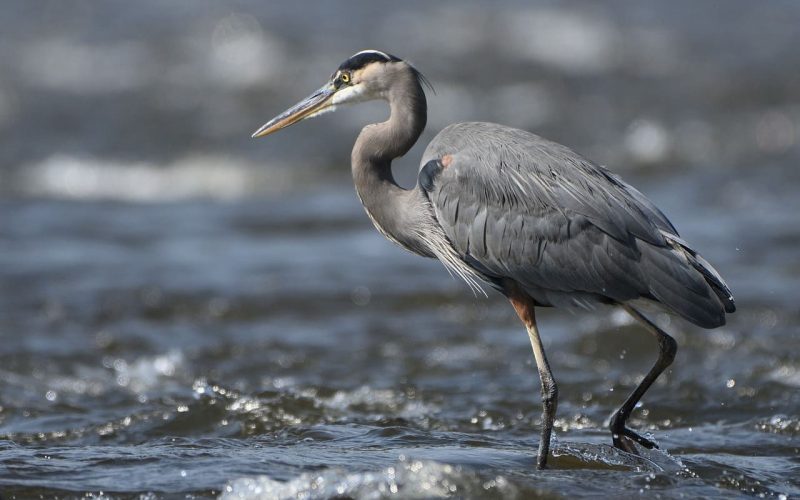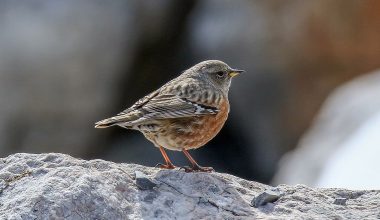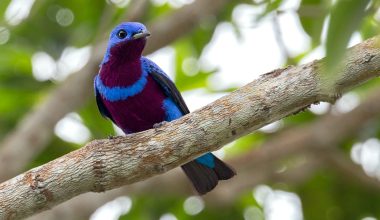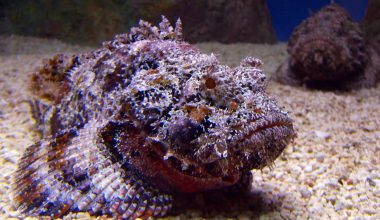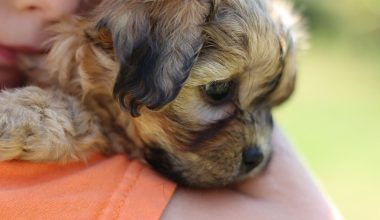Birds are found across the world and they fly differently depending on their wing type. There are few bird species that can soar through the sky, others must always flap their wings, some wings are helpful for diving as they propel themselves while diving underwater. There are many birds that migrate or fly south to escape cold winters. Species. The shape of the bird’s body is also different, Here is the list of long legged birds in the world,
Long Legged Birds
1. Black-Crowned Night-Heron
The black-Crowned Night-Heron scientific name is Nycticorax nycticorax is a medium-sized heron mostly seen in the regions of Europe, Asia, and North and South America. The body length ranges between 56 to 65 cm and the avarage weight is upto 800 gms. The total height of a Black-Crowned Night-Heron is upto 63 cm.
The dietary habits are carnivorous in nature and feed primarily on primarily fish and other aquatic life including frogs, tadpoles, snakes, turtles, lizards, larvae, and adult forms of insects, spiders, crustaceans, mollusks, small rodents, bats, chicks, and eggs of other bird species. The average lifespan of a Black-Crowned Night-Heron is between 20 to 30 years in the wild.
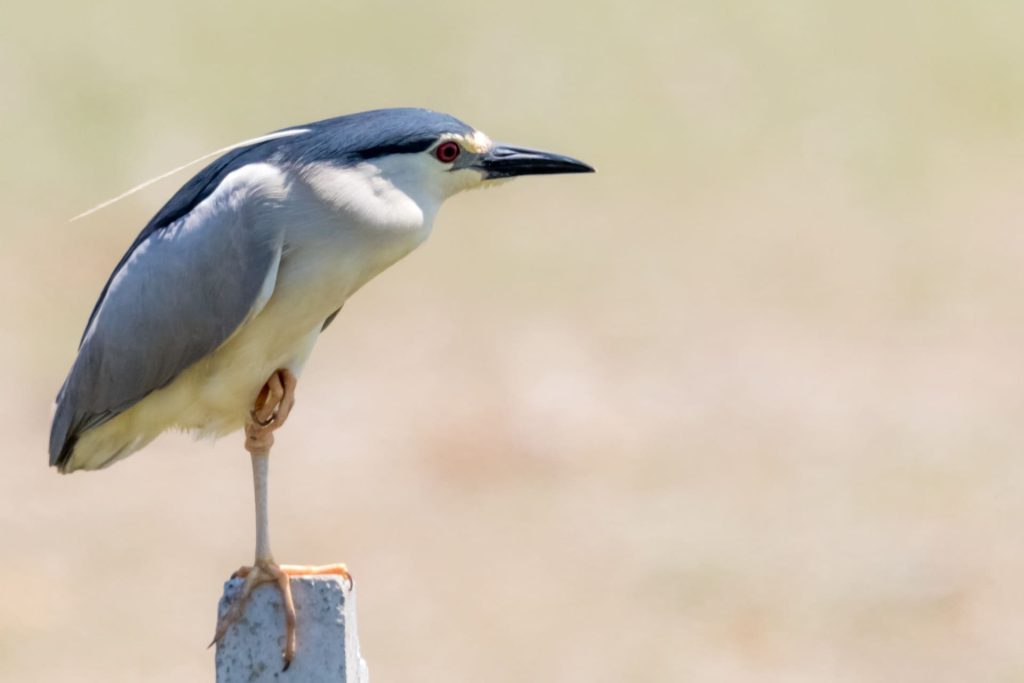
2. Yellow-Crowned Night Heron
The Yellow-Crowned Night Heron’s scientific name is Nyctanassa violacea is one of the popular species of night herons mostly seen in the Americas. The name of Yellow-Crowned Night Heron in French is “bihoreau violacé” and in Spanish it is “pedrete corona Clara”.
The body length of a Yellow-Crowned Night Heron ranges between 55 to 77 cm and the average weight is between 650 to 800 gms. The total wingspan is between 107 to 112 cm. The dietary habits are carnivores in nature and mainly feed on crustaceans, however, it is also seen eating fish, amphibians, snails, aquatic insects, and sometimes small snakes or young birds that have fallen from the nest.
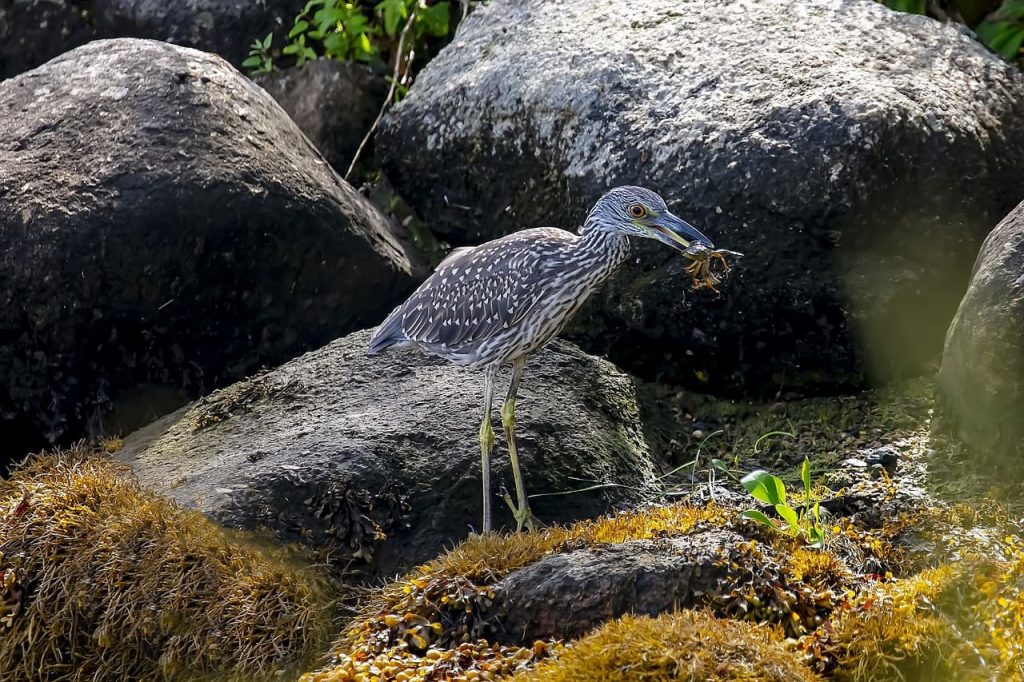
3. Great Blue Heron
The great Blue Heron is one of the long-legged birds and blue birds in Florida that belong to the heron family Ardeidae. The large wading bird was mostly seen on the shores of open water and in wetlands such as in the regions of North America, Central America, the Caribbean, and the Galapagos Islands. It is also listed as one of the blue and white birds in the world.
Great Blue Heron primarily feeds on fishes but it is also seen eating frogs, salamanders, snakes, lizards, young birds, small mammals, crabs, shrimp, crayfish, dragonflies, and grasshoppers, as well as many aquatic invertebrates. The body length ranges between 91 to 137 cm and the average weight is between 1.8 to 3.6 kg. It can fly with a speed of upto 55 km/h and its height is between 115 to 138 cm. The avarage lifespan of a Great Blue Heron is between 15 to 23 years in the wild.

4. Green Heron
Green Heron is a small heron species mostly seen in the regions of North and Central America. The body length ranges between 41 to 50 cm and the average weight is between 135 to 250 gms. The avarage lifespan of a green heron is upto 8 years in the wild. The dietary habits of green herons are carnivores, piscivores, and insectivores. It primarily feeds on fish, insects, amphibians, crayfish, invertebrates, earthworms, leeches, dragonflies, grasshoppers, small rodents, lizards, snakes, frogs, and tadpoles.
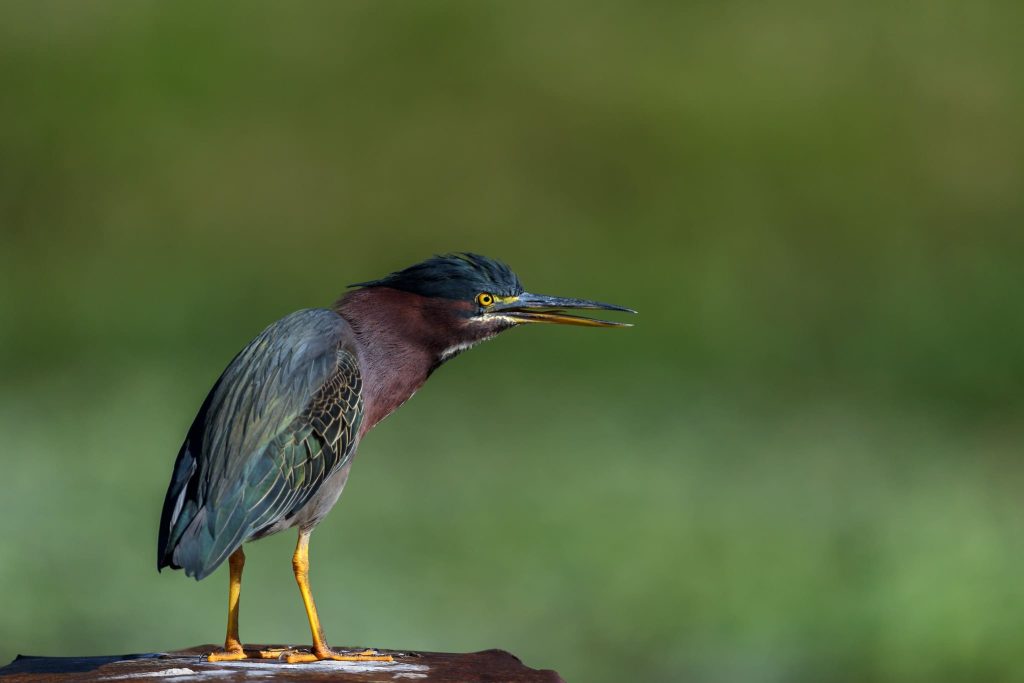
Image Source: Diana
5. Tricolored Heron
The tricolored Heron is a bird with a long neck formerly known as the Louisiana heron is a smalls species of heron mostly seen in the coastal regions of the Americas, the Atlantic region, and also in some parts of the northeastern United States, the Gulf of Mexico, and the Caribbean, to northern South America as far south as Brazil. It is one of the most amazing long-legged birds in the world.
The dietary habits are carnivores and piscivores, It primarily feeds on fish, but they also eat amphibians, crustaceans, gastropods, worms, leeches, spiders, and insects. The body length ranges between 56 to 76 cm and avarice wieght is between 334 to 415 gms. The total wingspan of the tricolored heron is upto 96 cm and the avarage lifespan is upto 17 years in the wild.

6. Striated Heron
Striated Heron also known as mangrove heron is a small heron species and one of the long legged birds that can grow upto 44 cm tall. The adult species can be identified with the help of a blue-grey back and wings, white underparts, a black cap, a dark line extending from the bill to under the eye, and short yellow legs. The young ones are browner and streaked below. The body ranges between 35 to 48 cm and avarice wieght is between 125 to 260 gms. The life expectancy of striated Heron is upto 8 years and primarily feeds on small fish, frogs, and aquatic insects.

7. Great Egret
The Great Egret is also known as the common egret or large egret distributed in the regions of Asia, Africa, the Americas, and southern Europe, however, it is also now spreading to northern areas of Europe. The body ranges between 80 to 104 cm and the average weight is between 700 to 1500 gms. The bird species can fly with a speed of 51 km/h and have a total height of upto 1 meter. The dietary habits of carnivores and piscivores in nature. It primarily feeds on aquatic animals, including frogs and crustaceans. They are also seen feeding on rodents and grasshoppers. It is also listed as one of the animals with long necks.
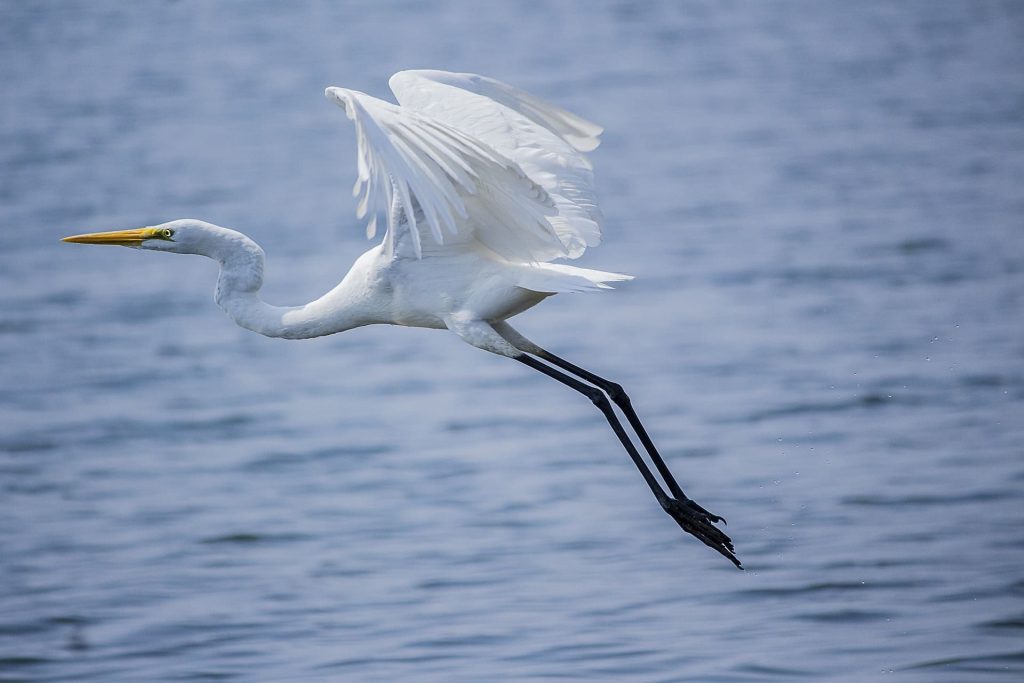
8. Cattle Egret
Cattle Egret is a species of heron that belongs to the family Ardeidae and breeds in the regions of the tropics, subtropics, and warm-temperate zones. The body length of a Cattle Egret ranges between 46 to 56 cm in length and the average weight is between 270 to 512 gms. The Cattle Egret can fly with a top speed of 51 km/h and the total wingspan is between 8 to 96 cm. The avarage lifespan of Cattle Egretis upto 23 years. It was originally native to parts of Asia, Africa, and Europe, however, now it has undergone a rapid expansion in its distribution and successfully colonized much of the rest of the world in the last century. It is also listed as one of the most beautiful white birds in the world.

9. Reddish Egret
The reddish egret is also one of the long legged birds that is a resident breeder in Central America, The Bahamas, the Caribbean, the Gulf Coast of the United States, and Mexico. The body length ranges between 68 to 82 cm in length and the total wingspan is between 116 to 125 cm. The average weight is between 364 to 870 gms and is considered one of the most active herons which are always on the move. It primarily feeds on fish, frogs, crustaceans, and insects. The avarage lifespan of a Reddish Egret is upto 12 years in the wild.
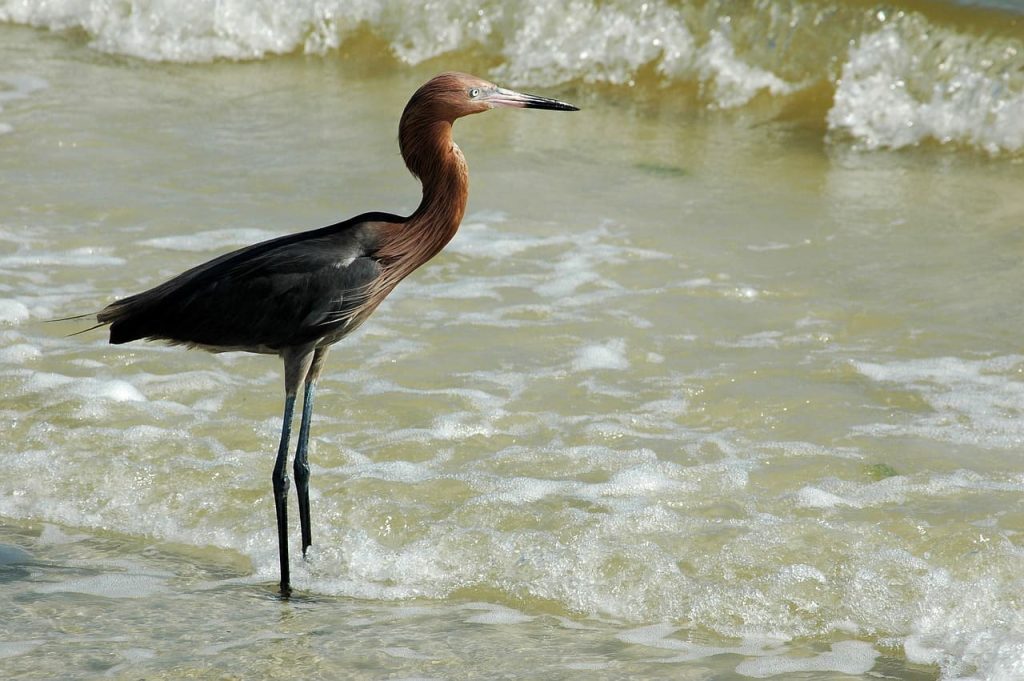
10. Wood Stork
The wood stork is one of the beautiful black and white birds that belong to the family Ciconiidae (storks). The body length will grow upto 1 meter in length along with a total wingspan of between 140 to 180 cm. The avarage weight is between 2 to 3 kgs. The dietary habits are carnivores, piscivores, and insectivores in nature, however, during the dry season, fish is the half diet along with crabs, insects, and frogs. This is one of the popular white birds in Florida that breed in North America and can travel over 80 kilometers (50 mi) to reach foraging sites using a wide variety of habitats.

11. American bittern
The American bittern is a wading bird species that belongs to the heron family. The bird species is mostly seen in the regions of Canada and the northern and central parts of the United States. During the winter season, the bird species migrate to the U.S. Gulf Coast states, all of Florida into the Everglades, the Caribbean islands, and parts of Central America. The primary diet includes fish and feeds on small vertebrates as well as crustaceans and insects. The avarage lifespan of the American bittern is upto 8 years of age in the wild.
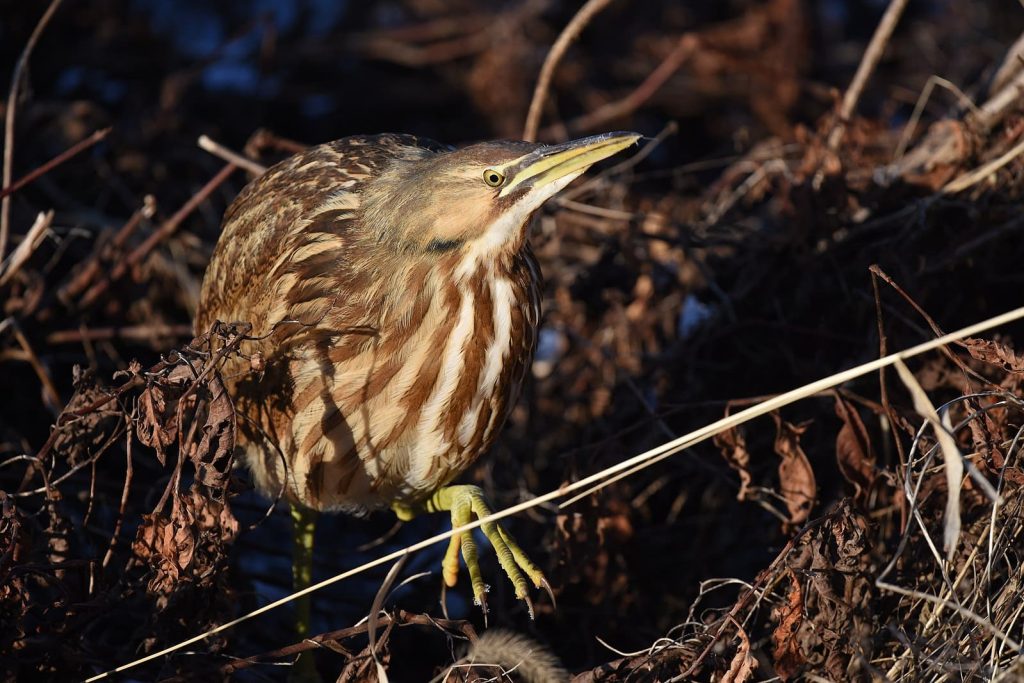
Image Source: Wikimedia
12. Snowy egret
The Snowy Egret is one of the most beautiful white birds in the world that belong to the heron family and looks very similar to the Little Egret in appearance. The name of the bird comes from its beautiful white plumage. It is also known as Lesser Egret, Little Egret, Little Snowy, Little White Egret, and Little White Heron. The bird can be easily identified by its slender black bill, black legs, and yellow feet. Both males and females have a similar appearance. The neck of the bird species is in the shape of an ‘S’ during flight.
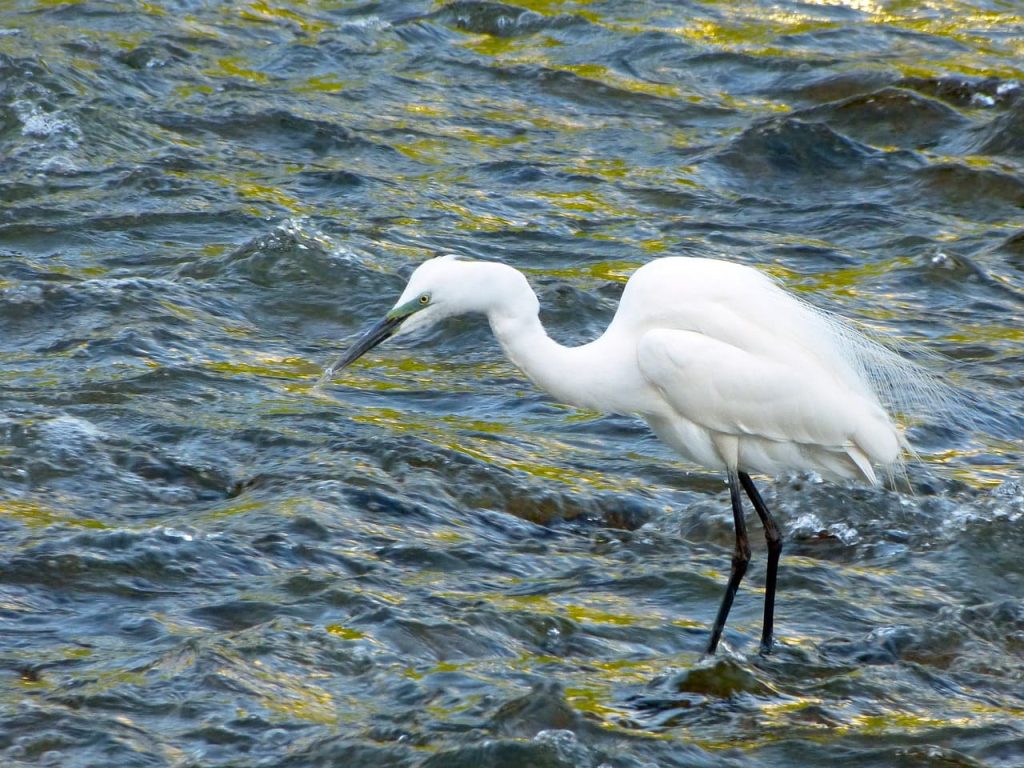
13. Whooping crane
The Whooping crane is one of the birds with long necks and also one of the tallest birds in North America. The adult species can be identified with the help of a red skin patch on their forehead, black “mustache” and legs, and black wing tips visible in flight. The avarage lifespan of a whooping crane is between 22 to 30 years in the wild. The bird species prefer wetlands, marshes, mudflats, wet prairies, and fields. The dietary habit is omnivores in nature and feeds on crustaceans, small fish, insects, amphibians, and reptiles, however, they are also seen feeding on grains, marsh plants, and acorns.
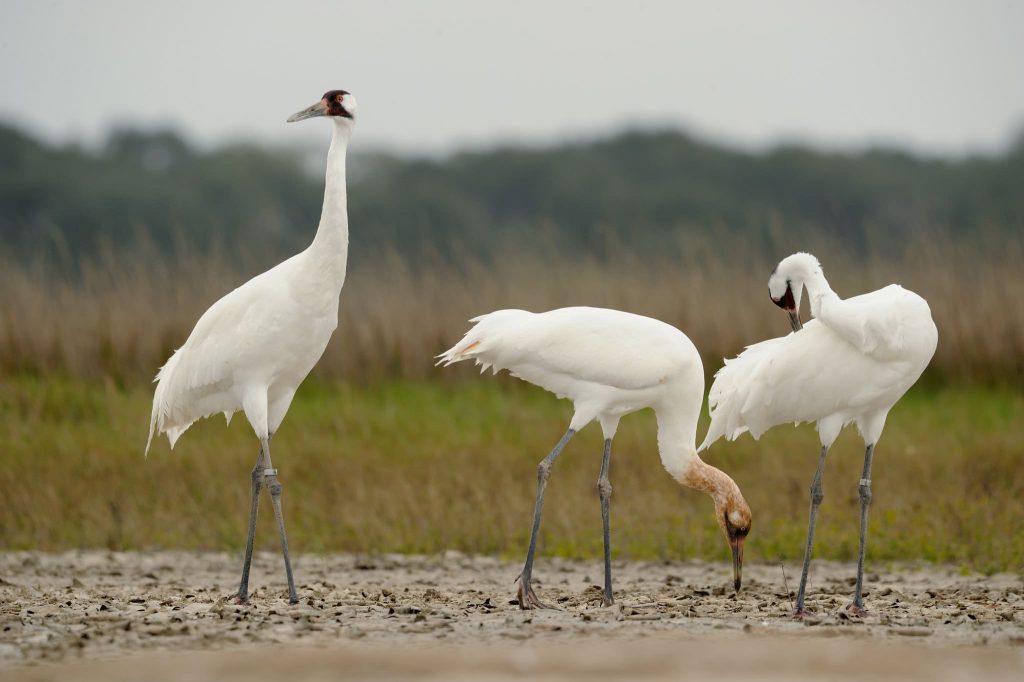
14. White-faced ibis
The white-faced ibis’s name comes from its white band surrounding its pink face, red eyes, and long, downward-curved red bill, however, juveniles are a bit browner along with pale cheeks, and patches of white feathers on the neck. They are mostly seen in southern South America and Mexico, however, those species living in Canada and the United States migrate during the winter season. They prefer thier nests in vegetation, trees, or on small islands. The female species lays three to five eggs that are incubated for around twenty days.
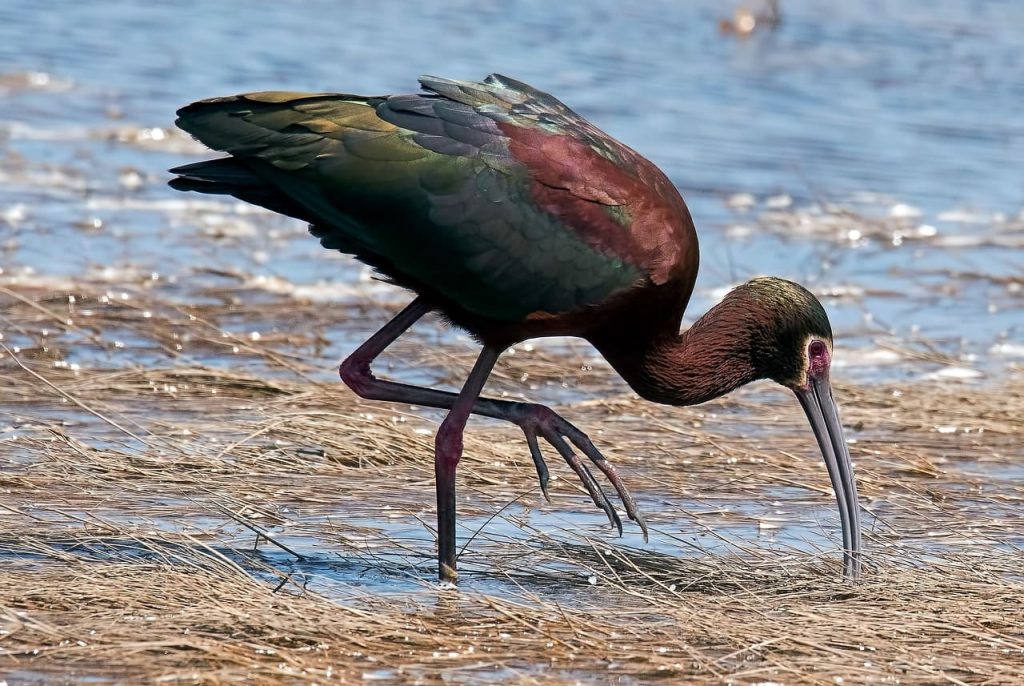
15. Roseate spoonbill
The Roseate spoonbill is one of the new pink birds that belongs to the Birdorable family. The pink color of the bird species comes from the food which is crustaceans who in turn have fed on algae. As of now, six species of spoonbill in the world are known to humans and the dietary habit is omnivores in nature and feeds on both plant and animal matter. The Juveniles are lighter in color and rely on adults for the first few months of life. It is one of the most popular tropical birds in the world.
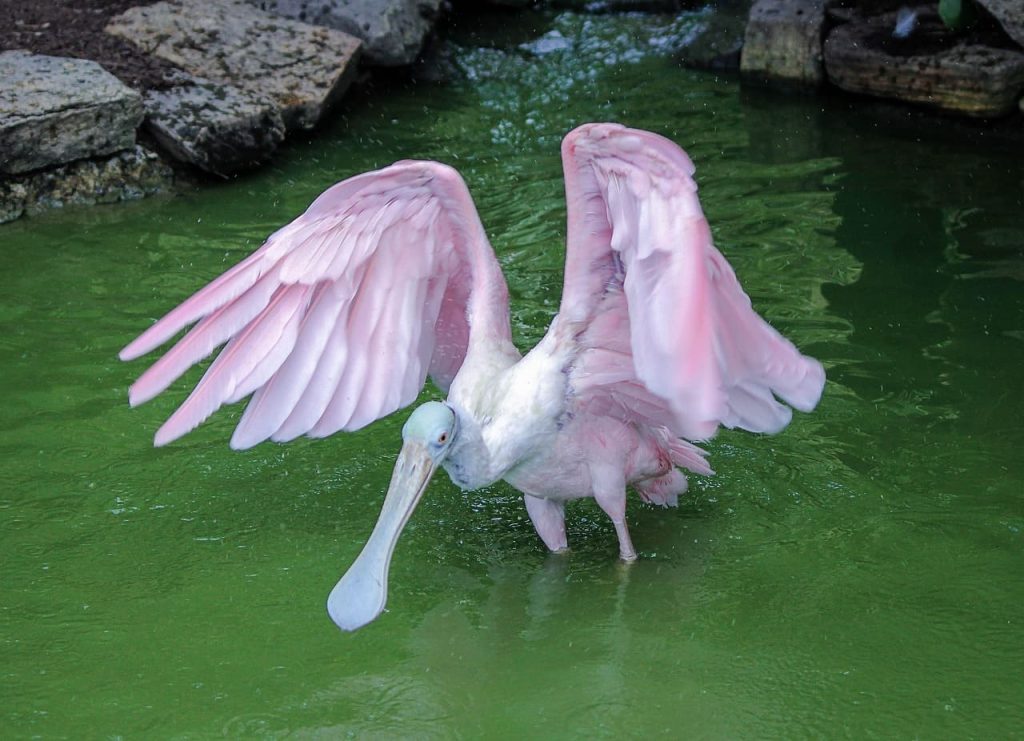
16. Limpkin
The limpkin also known as carrao, courlan, and crying bird belongs to the family Aramidae. They are mostly seen in the warm parts of the Americas, from Florida to northern Argentina. The primary diet includes mollusks, with the diet dominated by apple snails of the genus Pomacea. The name of the bird species comes from its seeming limp when it walks. The bird species are active during the day, but, forage at night. It is one of the long legged birds in the world.
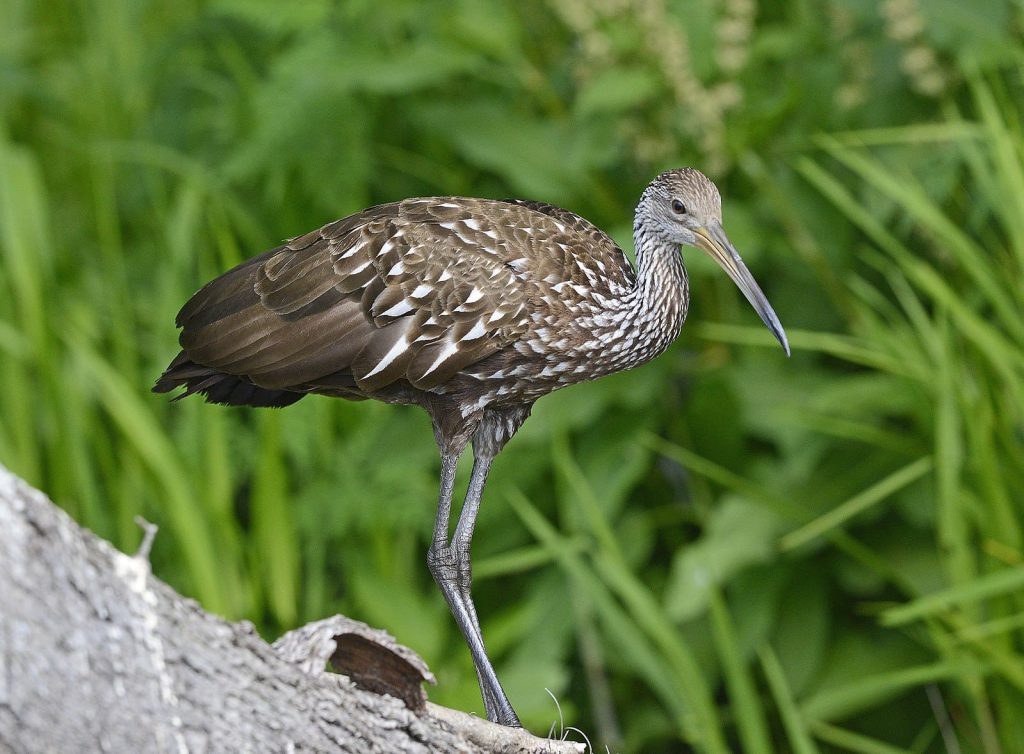
Image Source: Wikimedia
17. Jabiru
Jabiru, one of the long-legged birds scientifically known as Jabiru mycteria, is a large stock bird primarily seen in the Americas. The body length is up to 120 to 140 cm, and the average weight is between 4 and 9 kilograms. The average lifespan of jabiru is between 30 and 36 years in the wild. The name of the bird comes from a Tupi-Guaran language and means “swollen neck.” It is the tallest bird in South America and Central America based on its second-largest wingspan, followed by the Andean condor. The primary diet includes frogs, fish, molluscs, snakes, snails, insects, and other invertebrates.

Image Source: Allan
18. Scarlet ibis
Scarlet ibis is among the birds with long necks that can be identified with the help of red bills and feet; however, the bill is sometimes blackish, especially towards the end. These pink birds are found throughout South America and the Caribbean islands. Scarlet ibises are tropical birds that can fly long distances and move in flocks, forming an V formation. They like to roost in leaf canopies, mostly preferring the convenient shelter of young waterside mangrove trees. The best part about these red birds is that they are in protected states across the world. It is also listed as one of the red birds in Hawaii.
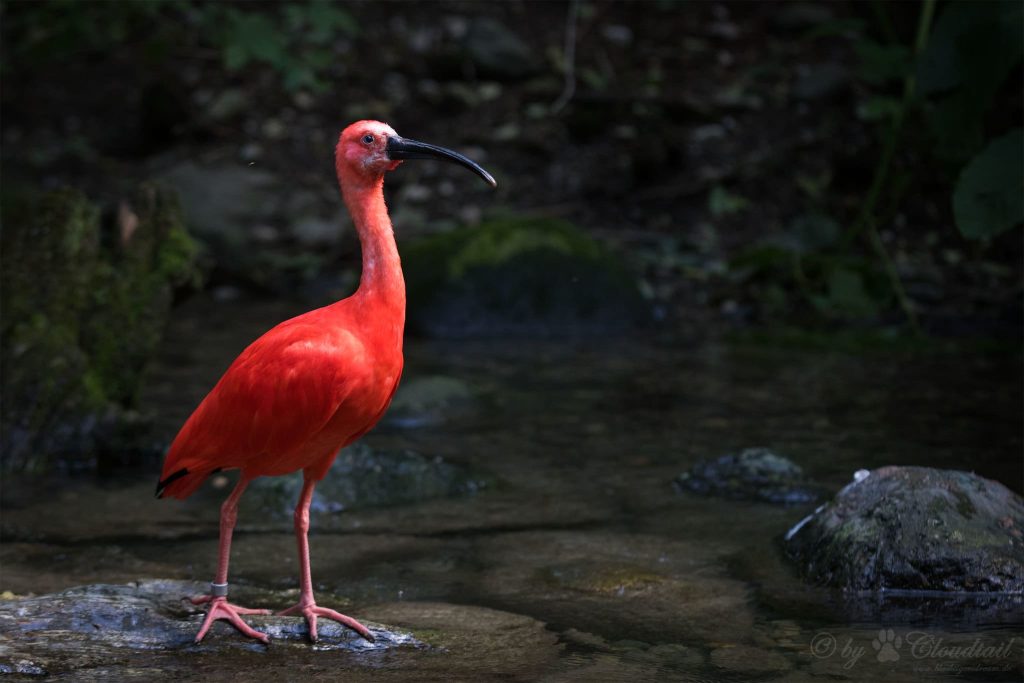
19. Grey heron
Grey heron is among the webbed feet birds and can be identified with the help of a pinkish-yellow beak and greyish-white below, with some black on the flanks. Most of the population exists in the northern parts of Europe and will migrate southward; however, there are some that remain in Central and Southern Europe. These birds are relatively abundant, and the estimated world population of adults is between 790,000 and 3,700,000 individuals.
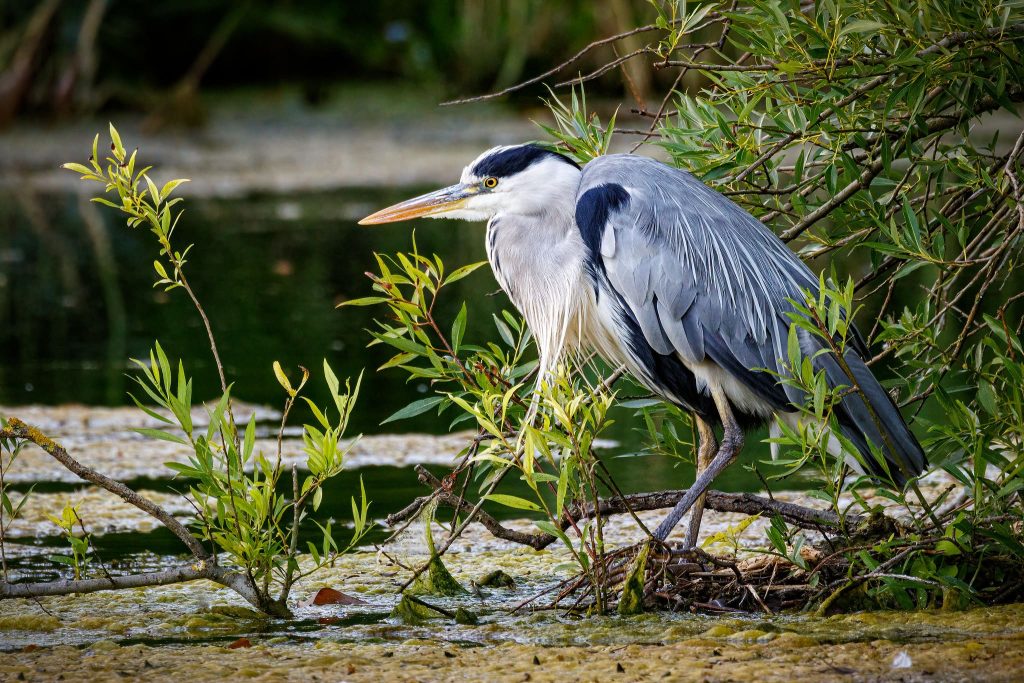
20. Purple heron
The purple heron is among the most popular purple birds in the world and breeds in Africa, central and southern Europe, and southern and eastern Asia. The adult species can be identified with the help of a black forehead and the crown of the head, with a dark stripe down the back of the neck that terminates in a slender, dangling crest. The sides of the head and the neck are buffish chestnut, along with dark streaks and lines down either side of the whole neck. The estimated population is between 270,000 and 570,000 purple herons in the world, and the population is probably decreasing slowly.
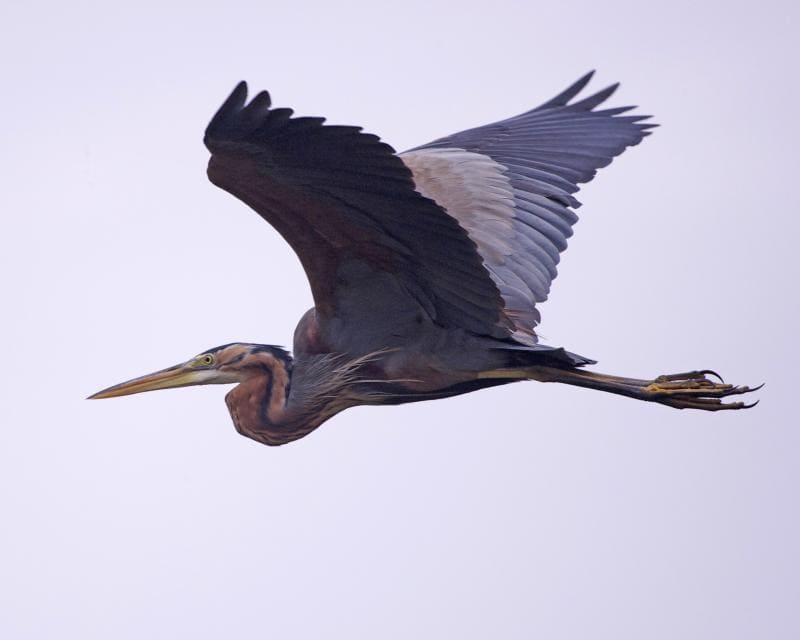
21. Purple gallinule
The purple gallinule, scientifically known as Porphyrio martinicus, is a bird species that belongs to the genus Porphyrio. The body length is up to 26 to 37 cm, and the average weight is between 141 and 305 grams. The average lifespan of purple gallinule is up to 22 years in the wild. The bird species belongs to the rail family, which includes crakes, coots, and gallinules. These bird species are seen across the southeastern states of the United States and reside in southern Florida, the Gulf and Pacific coasts of Mexico, parts of Central America, and the Caribbean.
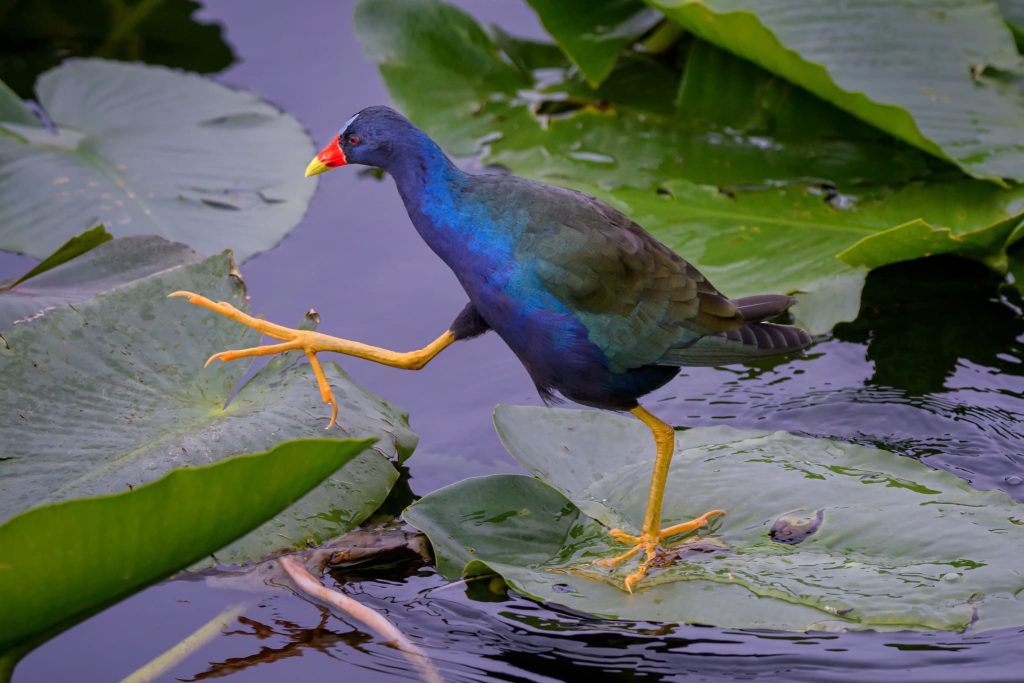
Image Source: Diana
This is the list of long legged birds in the world. Kindly share and do share your comments.
